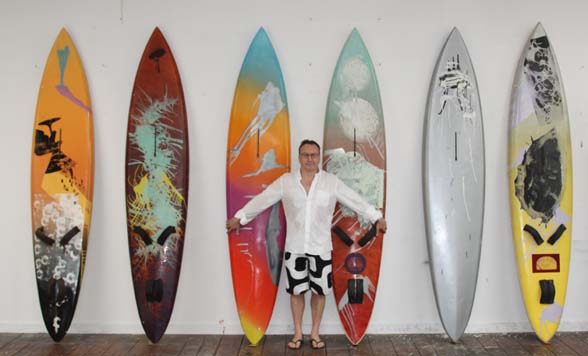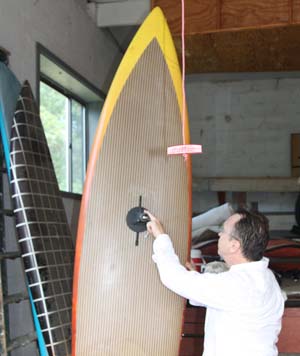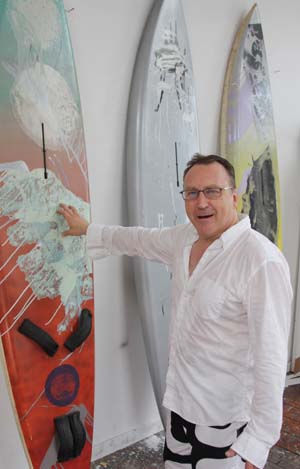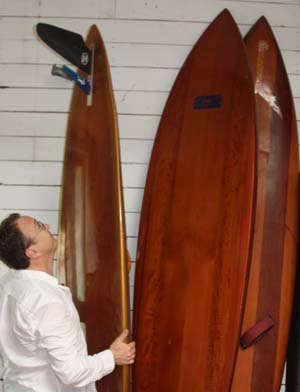
Miller Takes His Art For A Ride In The Surf
By Colin M. Graham

Artist Steve Miller in front of six of the windsurfing boards that he custom painted. Photos by Colin M. Graham
Other than just painting them, Miller also designed two himself, experimenting with different materials, volumes and shapes to get a board that would work well in the conditions he often found himself facing here on the East End.
 Sagaponack – Artist Steve Miller’s studio, a converted potato grading barn once owned by artists Frank Stella and Neil Williams, looks very much like what one would expect an artist’s studio to be; there are racks filled with canvases, painting supplies, works in progress hanging on the walls, silkscreening equipment to one side and paint splatters on the floor alluding to the bodies of work completed in the space, but along one wall is something you might not expect to see: a series of hand-painted windsurfing boards, some of which bear the scars of having been ridden.
Sagaponack – Artist Steve Miller’s studio, a converted potato grading barn once owned by artists Frank Stella and Neil Williams, looks very much like what one would expect an artist’s studio to be; there are racks filled with canvases, painting supplies, works in progress hanging on the walls, silkscreening equipment to one side and paint splatters on the floor alluding to the bodies of work completed in the space, but along one wall is something you might not expect to see: a series of hand-painted windsurfing boards, some of which bear the scars of having been ridden.
Miller, whose work encompasses the disciplines of painting, silkscreening, drawing and working with mediums like x-ray images and lines of code from the particle collider at Brookhaven National Laboratories, developed a passion for windsurfing back in the early 1980s. “I got into it because a friend of mine had a board and said ‘you’ll love it you’ve got to try it,'” said Miller while going through his “quiver” – a trailer filled with at least seven different types of boards and types of sails. “I had taught skiing professionally for years so I got up almost immediately. I did the classic go out and think this is great and get out half a mile and you have no idea how to turn so they had to come out in a boat and rescue me and turn me around so I could get back to shore,” he laughed.
The images Miller silkscreened onto the boards are an extension of his art and his technique.
 From this first introduction to the sport Miller began to experiment with board design, fine tuning different models to suit the conditions he most found himself in here on the East End. “It was relatively early on in the sport and I was trying to figure out how to make the best possible board for the conditions out here, which are very sporadic,” explained Miller. “I wanted a board that will go out in that 12 to 15 mph slot. They weren’t making the boards that they make now that go in like three mph winds.”
From this first introduction to the sport Miller began to experiment with board design, fine tuning different models to suit the conditions he most found himself in here on the East End. “It was relatively early on in the sport and I was trying to figure out how to make the best possible board for the conditions out here, which are very sporadic,” explained Miller. “I wanted a board that will go out in that 12 to 15 mph slot. They weren’t making the boards that they make now that go in like three mph winds.”
So he drew up some specifications for the type of board he wanted and sent them to Naish, a company headed up by world champion windsurfer Robbie Naish. “I gave them the specs and they shaped it the way I wanted it and then I painted it. Then I started trying other things. The second board was made in the late 1980s out of carbon fiber, which was revolutionary at the time. What we did on that was try a triple concave design on the bottom. The idea on the triple concave was trying to figure out how to get the maximum efficiency in water flow off the start,” said Miller. “The idea was to give you a board with the maximum amount of flotation, triple concave to get the water flow going faster to get you on plane as fast as possible.”
Another part of his collection are a series of light weight, low density foam core boards wrapped in wood veneer. “It really needs to be blowing to use these,” he explained. “I don’t really us these anymore, now they’re pretty much a fashion statement.”
 Since different conditions like wind speed and surface chop necessitate different types of boards, Miller soon found himself the owner of quite an impressive collection. “I got into designing them just for fun,” said Miller of his creations. “I did nine boards, designing two of them myself. All of these I painted by spraying them with auto body enamel and then silkscreening patterns on top of them,” he said. “Some of these images came from my work. I don’t know why I wanted to do the martini board, I guess that’s where I was in those days,” he smiled.
Since different conditions like wind speed and surface chop necessitate different types of boards, Miller soon found himself the owner of quite an impressive collection. “I got into designing them just for fun,” said Miller of his creations. “I did nine boards, designing two of them myself. All of these I painted by spraying them with auto body enamel and then silkscreening patterns on top of them,” he said. “Some of these images came from my work. I don’t know why I wanted to do the martini board, I guess that’s where I was in those days,” he smiled.
“These are actually AIDS viruses and I got into all these electron microscopic imagery in my own work and I thought this would be really cool to do in terms of the idea of being inside the body, which is liquid, and then sailing these things in the bay,” he said of another board in his collection.
But with his busy schedule and two art exhibits coming up in the next two weeks, Miller admits that he hasn’t had the time to sail as much as he used to. “I haven’t been sailing as much as I’d like, I’ve basically just been biking and doing yoga,” he said with a tinge of longing in his voice. “When I was really into it, if it was blowing I would go no matter what I was doing, but my life just isn’t that way right now. I’ve just got other stuff that’s more important.”
